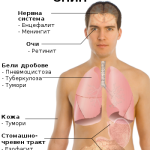Mental health articles
OF mental health care and mentally ill
Conversion Disorder and Associated Psychopathology

The image illustrates some theory of famous psychologist Melanie Klein, advanced by John Steiner (1979). The theory is about how Borderline Personality Disorder develops and how it interacts with other disorders (Photo credit: Wikipedia)
One reason that conversion disorder has questionable utility as a diagnostic entity is because this disorder often co-occurs with a variety of psychiatric disorders and personality styles. Although patients with conversion disorder are generally considered more likely to have hysterical personality disorder, this relationship has fueled a great deal of controversy. Chodoff and Lyons stated that hysterical personality is a description of women by men and is basically a caricature of femininity. This stereotyping seemingly also holds for men. One group of authors suggested that hysterical personality disorder in men reflects a homosexual process, and if not a homosexual process, then these men are likely to have sexual problems and display ‘‘affectations’’. Kendell strongly stated that hysterical personality is a label used to describe a woman if the individual is perceived as difficult, demanding, and manipulative, whereas the same symptoms observed in a man will lead to the label of psychopathy. The DSM-IV (APA, 1994) presentation of histrionic personality disorder includes the following traits: overly dramatic, incessant need for attention and reassurance, sensation seeking, reactions out of proportion to minor stimuli, irritability with outbursts of anger, shallowness, vanity, and proneness to manipulative suicidal gestures.
Past studies have essentially used variations of the DSM-IV definition of histrionic personality disorder. A comprehensive review of studies of hysterical personality characteristics dating from 1949 to 1970 was conducted by Alacron. Analysis of fourteen studies revealed a high degree of consensus for hysterical personality traits including emotional lability, dependency, excitability, egocentrism, and suggestibility. Alacron concluded that all patients with hysteria have some of the features of hysterical personality, whereas not all patients with hysterical personality will have typical features of hysteria. The estimated percentage of the co-occurrence of conversion and hysterical personality has ranged from 5 to 50%. Ziegler et al. noted that less than half of their sample of 134 conversion patients had ‘‘hysterical character,’’ which led the authors to conclude that the hysterical personality pattern was not a prerequisite for a conversion process. Barnert found that 7% of forty-six patients with conversion reactions exhibited a hysterical personality disorder. Of fifty patients with a DSM-III diagnosis of conversion disorder, only 6% of the cases had cooccurring histrionic personality disorder.
Given the difficulty in determining the validity of conversion disorder and the almost anecdotal definition of hysterical or histrionic personality, it is not surprising that determining the true cooccurrence of these two conditions is problematic. Although hysterical personality disorder may predispose individuals to conversion reactions, no single personality pattern characterizes individuals with conversion disorder. Of greater interest is the relationship of depression and schizophrenia to conversion reactions. Ziegler et al. found rates of 29.9% for depression and 14.2% for schizophrenia in their conversion patient sample, and in another sample, prevalence rates of 17% for depression and 7% for schizophrenia were observed. Barnert reported overt depression in 33%, covert depression in 21%, and schizophrenia in 7% of patients diagnosed with conversion symptoms. Lewis and Berman observed that eight out of fifty-seven conversion patients evidenced schizophrenia or schizoid character. Roy found that 88% of fifty patients with hysterical conversion had depression and suggested that conversion symptoms may serve more as a ‘‘signal of distress’’ than anything else. Folks et al. indicated that 44% of their sample did not have any psychopathology other than conversion disorder but noted that 8% of their patients had depression and 29% had somatization disorder concurrent with conversion reactions. Two studies by the same group of investigators examined differences between conversion and somatization disorders. In the first study, the investigators reviewed charts of patients seen over a 2-year period at a large medical center. Cases were assessed for conversion disorder (N = 51) and somatization disorder (N = 65) using DSM-III criteria. Seventy-eight percent of the conversion disorder group and 95% of the somatization disorder group were women. Conversion disorder cases were overrepresented in the neurology services, whereas somatization patients tended to come from all units throughout the hospital. Age of onset occurred across the life span of the conversion group and tended to occur before 21 years of age in the somatization disorder group. The somatization disorder group tended to have a greater history of depression, attempted suicide, panic disorder, and divorce, suggesting that conversion disorder was less pathological than somatization disorder. The investigators then went on to follow the course and outcome of these patients during a 4-year period. Still using DSM-III criteria, the conversion disorder group (N = 32) and the somatization disorder group (N = 38) were given follow-up interviews by a rater blind to the baseline diagnosis. Patients in the conversion disorder group were less likely to be given the same diagnosis at follow-up than patients in the somatization disorder group. Interestingly, six cases in the conversion disorder group were given a diagnosis of somatization disorder at follow-up and four other cases in the conversion disorder group were eventually diagnosed with an organic condition. Follow-up comparisons of overall distress and impairment were made using the Symptom Checklist-90 and the Short-Form General Health Survey. Again, the somatization disorder group displayed higher levels of emotional turmoil and functional impairment relative to the conversion disorder group. These two studies are compromised by the retrospective nature of the design, as well as diagnoses based on chart review. In one of the more rigorous studies of conversion reactions, Binzer, Andersen, and Kullgen examined thirty consecutive patients with conversion disorder, motor symptom subtype, and compared them to a control group with corresponding motor symptoms due to an organic lesion. All patients were assessed with the DSM-III-R diagnostic system, the Hamilton Depression Rating Scale, and a special life events schedule. The results indicated that the conversion group had a higher degree of psychopathology. Thirty-three percent of the conversion group had an Axis I diagnosis, and 50% had an Axis II diagnosis, compared to 10 and 17% of control group patients, respectively. The conversion group also had higher depression scores and special life events before the onset of conversion symptoms. A logistic regression analysis indicated that low education, the presence of a personality disorder, and depression were associated with increased risk of conversion disorder. Clearly, further research is needed to determine whether conversion disorder represents a unitary diagnosis or should be considered more as part of another psychiatric condition.
Conservatively, conversion reactions can be thought of as the ‘‘tip of the iceberg,’’ suggesting the presence of other concurrent psychiatric disorders or serious medical disorders. La Belle Indifference.The assumed sine qua non of conversion disorder is la belle indifference, or what is referred to as an indifference or lack of concern toward symptoms on the part of conversion patients. Chodoff noted that la belle indifference occurred as often as not in his sample of hysterics. He speculated that la belle indifference represented an example of the use of denial to defend against psychological stressors and not an indifference per se. Other studies reported la belle indifference in 30%, 41%, and 54% of their respective samples. One of the better studies that argued against the presence of la belle indifference in conversion hysteria was provided by Lader and Sartorius. The authors compared a self-report of anxiety, psychiatrist ratings, and psychophysiology in a conversion hysteria group and an anxiety disorder group. The patients in the conversion hysteria group rated themselves as significantly more anxious than did the anxiety group, whereas the ratings of patients by examining psychiatrists were in the opposite direction, that is, psychiatrists rated conversion hysteria patients as less anxious than anxiety patients. As measured by galvanic skin response, patients in the conversion group (N = 10) displayed higher autonomic levels of arousal than the comparison anxiety group (N = 71) and a normal control group (N = 75).
In another study, Meares and Horvath indicated that a group of seventeen patients who suffered from conversion could be separated on the basis of psychophysiological and biographical variables. One group, identified as ‘‘chronic hysterics,’’ had more debilitating conversion symptoms, poor interpersonal and occupational coping skills, and longer histories of multiple medical complaints than a second group identified as ‘‘acute hysterics.’’ In addition, the chronic hysterics displayed higher levels of heart rate, sweat gland, and muscle activity than the acute hysterics. On closer analysis of these two groups, the chronic hysterics label may be a misnomer; the profile obtained by chronic hysterics is more consistent with a somatization disorder profile. Despite the long history, la belle indifference is not a reliable indicator or marker of conversion disorder. Conversion disorder patients are actually quite concerned about their symptoms, although this concern may not be readily apparent. A true indifference to symptomatology or disability is usually indicative of central nervous system damage.
Related articles
Post Footer automatically generated by wp-posturl plugin for wordpress.
More from my site
Tags: conversion, disorder, psychopathology









Leave a Reply